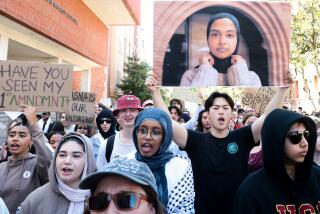The bombing of the L.A. Times
On the morning of Oct. 1, 1910, shortly after 1 a.m., a series of explosions rocked the Los Angeles Times building. An entire six-floor wing of the stone structure was thrown free of its foundation. Then all at once the building’s south wall, the Broadway Street side, cascaded to the ground.
There were six blasts in all. About 100 people had been at work, and now they were all trapped in flames, smoke and debris. Escape was a battle. Twenty-one people died.
What caused the explosion? Was it a gas leak? An anarchist bomb? An attack by union members who opposed the adamantly closed-shop policies of the paper’s owner, Harrison Gray Otis? Or was it an insurance scam, a scheme to benefit from the $100,000policy the paper had recently taken on the structure?
William J. Burns, a celebrated private detective and former Secret Service agent -- a dapper man with a fondness for three-piece suits and bowler hats and a thick, bristly mustache -- was hired by Los Angeles Mayor George Alexander to solve the case. Donning a variety of disguises, working covertly, the investigation by this “American Sherlock Holmes” relentlessly followed a trail that led across turn-of-the-century America, from San Francisco boatyards, to an anarchist colony outside Seattle, to a hunters’ camp in the snow-covered woods of Wisconsin, to a Chicago fortune teller and, finally, to the downtown streets of Indianapolis.
In the course of his dogged investigation, the detective came to realize that he had uncovered a large, previously unimaginable, conspiracy: The bombing of The Times, it seems, had been one of more than 100 bombings at nonunion sites throughout the country organized by the same group of people. “The war with dynamite,” he decided, “was a war of anarchy against the established form of government of this country.”
In the end, Burns got his men. He apprehended the three principals he was certain were directly responsible for The Times bombing -- including J.J. McNamara, an official of an Indianapolis-based ironworkers union, and his younger brother.
After the arrests were announced, Samuel Gompers, the president of the nationwide American Federation of Labor, quickly declared that “Burns had lied” and that the case against the McNamaras and the ironworkers union was “a frame-up.” Gompers persuaded Clarence Darrow, the already legendary populist attorney, to defend the McNamara brothers.
In the tense, high-stakes months before the trial, a tenacious, deeply personal battle between Burns and Darrow was fought in the shadows. They were two committed individuals, each confident of the inherent rightness of his cause, each convinced that at stake was nothing less than the nation’s security and constitutional integrity. They also were both deeply flawed men -- egotists, temperamental and morally pragmatic. They routinely manipulated the levers of justice and cranked up the roar of public opinion with little regard for either the law or the truth.
Burns had no qualms about imprisoning suspects in secret locations until a confession was coerced. He covertly took the suspects by train across the Midwest to Los Angeles to avoid, as he put it, “habeas corpus proceedings and all sorts of trouble.” He intercepted the mail of people connected, however tangentially, to the case. He hid Dictaphones in the conference room of the opposing lawyers and in the prisoners’ cells in the L.A. County jail, and he received thick transcripts of his adversaries’ conversations and strategy sessions. And he disclosed to eager reporters nasty stories about the suspects’ freewheeling romances -- inventing many of these salacious tales in the process.
Darrow, for his part, gleefully fed the press unfounded accusations and encouraged fallacious reports dismissing the evidence against the unions as fabricated. More disturbing, Darrow, who had already earned a reputation as a champion of justice, succumbed to the pressures of the case -- and, with breathtaking pragmatism, undermined and disregarded the law.
Acting on his behalf, his associates offered inducements to witnesses to change their stories; they dangled the carrots of cash or new jobs and, when that failed, they shook a stick that warned of impending bodily harm. Darrow himself passed $500 to one of Burns’ most trusted lieutenants in the belief -- which proved incorrect -- that he had recruited a spy in the enemy’s camp. And when these machinations failed, Darrow allegedly approved a plot to bribe two jurors. One of the indignant jurors, however, informed the authorities, and when the money was exchanged on a downtown street corner, the police swooped in.
The trial of the McNamaras ended with guilty pleas; Burns’ evidence against them, even Darrow was at last forced to concede, was overwhelming.
But then Darrow was indicted for bribing a juror. The People vs. Clarence Darrow went on for three incriminating months in a courtroom across the hall from where the McNamaras had been on trial. In the end, it was Darrow’s summation that saved his reputation. “It was a hard fight,” he told the jurors, and then shared an impassioned account of his crusading life. Tears were racing down his face as he finished, and the jury wept unashamedly along with him. He was acquitted.
There was a second bribery trial, but Darrow won this one too. He returned to Chicago filled with a deep shame about many of his actions. He went on to fight for John Scopes’ right to teach evolution in Tennessee, and he crusaded against the death penalty in the 1924 Leopold and Loeb murder case.
As for Burns, in time he turned to politics. He was appointed the first director of the Bureau of Investigation, the agency that would become known as the FBI. But he was blindsided by the Teapot Dome scandal and soon resigned. He appointed his young assistant to take his place. J. Edgar Hoover served as director for nearly the next half a century.
Howard Blum, a contributing editor at Vanity Fair and a former New York Times reporter, is the author of “American Lightning: Terror, Mystery, the Birth of Hollywood, and the Crime of the Century.”
More to Read
Start your day right
Sign up for Essential California for news, features and recommendations from the L.A. Times and beyond in your inbox six days a week.
You may occasionally receive promotional content from the Los Angeles Times.






